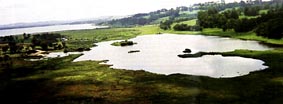Peat Mining
 |
 |
 |
 |
 |
 |
 |
 |
 |
 |
|
Effects on Water Quality |
|
|
Opponents to mining argued that further mining would compromise the filtering function of the swamp as well a sits ability to retain nutrients. This would impact on water quality in the reservoir as well as habitat for flora and fauna in the area. The impacts are exacerbated by the growing size of the dredge pool, the diminishing size of the swamp and the construction of drainage channels.
According to Australian Water Technologies:
Peat is rich in fulvic and humic acids which impart yellowish-brown colour to water. In peat mining, drainage and disturbance release these materials, with potential adverse effects on the quality of waters receiving the drainage. These effects can usually be alleviated by allowing the effluent to flow over undisturbed peat beds, where the dissolved substances can be adsorbed and the solids settled. Bubbles of methane formed and trapped in peat tend to obstruct drainage, so reducing and slowing internal flows...
The Wingecarribee Reservoir was subject to algal blooms caused by concentrations of nutrients and in the summer of 1996/97 algal concentrations exceeded limits set by the National Health and Medical Research Council (NHMRC) several times. According to Australian Water Technologies:
The dredge pool contained high concentrations of phosphorus. Increase in the size of the pool would be likely to increase the quantity of phosphorus in the water, even if the concentration were to decrease. During flood events there is the danger that this water will be displaced into the lake, overwhelming the capacity of the remaining, and smaller, swamp barrier to remove the contaminants, which would mainly flow over the surface. As the volume of the dredge pool increases the danger of the lake receiving pulses of phosphorus-rich water, which can lead to algal blooms, will increase.
According to the Department of Mineral Resources:
The Wingecarribee reservoir has in fact suffered in recent times from a blue-green algal bloom. That bloom has not yet produced dangerous toxins but may do so... The mechanisms which determine whether such blooms produce toxins are not well understood and the present substantially harmless bloom could become a serious problem with little warning. Drainage channels, constructed by the peat miners, cross the swamp area and are typically 1m deep. Their purpose is to drain surface water from the swamp and dry it out sufficiently to enable machinery and animals to be able to cross its surface. According to the Department of Land and Water Conservation:
The drainage of the surface of the swamp by the channels alters flows patterns resulting in alteration of the filtering capacity of the swamp. Water travels more quickly through artificial drains than through natural wetlands... during low flow conditions, the channels in Wingecarribee Swamp could be the major flow path for water to traverse the swamp from upstream to Wingecarribee reservoir, if the volume of water flowing at that time is within the capacity of the channels.
In September 1997 the Environmental Protection Authority (EPA) served notice on Emerald Peat "to take immediate steps to prevent muddy discharges from the operation from entering Wingecarribee Reservoir". This followed the appearance of a "muddy yellow slick" which spread across the surface of the Reservoir, covering half the surface at times. Emerald Peat was order to install appropriate filters and move its boat loading location.(EPA News Release 26/9/97) Because the slick had released phosphorous into the storage, the Wingecarribee Council and the Sydney Water Corporation (SWC) were also concerned about its potential to create an algal bloom. As a result the SWC was conferring with Wingecarribee Council about upgrading water treatment for the water supply. (ABC Illawarra 16/9/97) This was estimated to cost about $600,000 by the Wingecarribee Council. Emerald Peat proposed to install a revised water treatment arrangement to upgrade the existing system if its leases were renewed. This upgrading would involve:
According to Emerald Peat:
References: AWT Ensight Consulting Services, Report on Water Quality Issues in relation to Peat Mining in Wingecarribee Swamp, Report No. 97/36, February 1997, Exhibit 35, pp. 7, 13-14. Andrew Philippa Resource Officer, Catchment Planning Sydney South Coast Region, Department of Land and Water Conservation Hydrology Comments, Mine Warden Inquiry, May 1997, Exhibit 88. Department of Mineral Resources, Submission to Inquiry into Renewal of Mining leases 567 and 568 at Wingecarribee Swamp, 1997.
|
Home
| Story in Brief
| About Peatlands
| Value of Swamp
| History of the Swamp
Mining Impacts
| Role of Government
| Collapse of the Swamp
References | Glossary
| Site Map | Credits/Contacts
http://www.herinst.org/wingecarribee/
 Although
water seeping from the swamp into the lake lacks oxygen and is highly
coloured and rich in iron, its impact appears to be relatively small
because of the low rate of flow...
Although
water seeping from the swamp into the lake lacks oxygen and is highly
coloured and rich in iron, its impact appears to be relatively small
because of the low rate of flow...